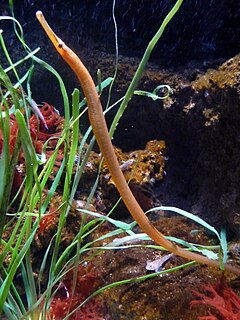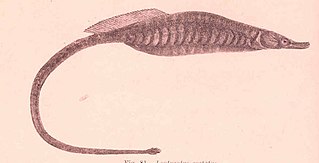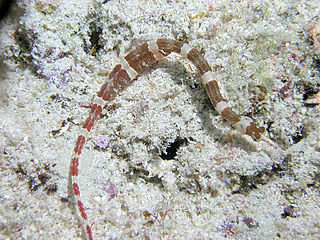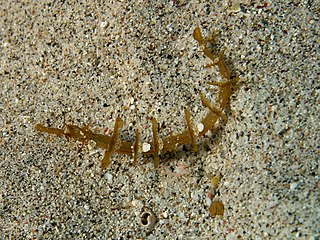
The Syngnathidae is a family of fish which includes seahorses, pipefishes, and seadragons. The name is derived from Ancient Greek: σύν, meaning "together", and γνάθος, meaning "jaw". The fused jaw is one of the traits that the entire family have in common.

Pipefishes or pipe-fishes (Syngnathinae) are a subfamily of small fishes, which, together with the seahorses and seadragons, form the family Syngnathidae.

The lesser pipefish or Nilsson's pipefish is a pipefish similar to the greater pipefish, but with no crest above the head. Usually it reaches up to 17 centimetres (6.7 in) in length, maximally 18 centimetres (7.1 in), although in South Wales they are usually not more than 10 to 13 centimetres long. They have a light to dark green-brown colour with bar-like markings on the sides. Lesser pipefish are found all around the British Isles and as far as the French coast, although they have now been recorded in the Mediterranean Sea.

The alligator pipefish or double-ended pipefish is a species of fish in the family Syngnathidae and is the only species in the monotypic genus Syngnathoides. It is found in shallow water in the tropical and subtropical Indo-Pacific, its range extending from East Africa to northern Australia. This fish lives in habitats of seagrass and seaweed, and hides by positioning itself vertically with its head down amidst the similar-coloured fronds of vegetation. The elongated, well-camouflaged body can reach 29 cm (11 in) in length. It feeds by sucking up its prey.

The black-striped pipefish is a species of fish in the family Syngnathidae. It is found in the eastern Atlantic from the southern Gulf of Biscay to Gibraltar, also in the Mediterranean and Black Seas. As the introduced species it is mentioned in the Caspian Sea and fresh waters of its basin.

The estuarine pipefish or river pipefish is a species of fish in the family Syngnathidae. It is endemic to South Africa and has been sporadically recorded in the estuarine portions of the Kariega, Kasouga, Bushmans, East Kleinemonde and West Kleinemonde rivers. It can be readily distinguished from another southern African pipefish with which it shares its habitat, S. temminckii, by its much shorter snout. The estuarine pipefish is most commonly found in beds of the eelgrass Zostera capensis.

Corythoichthys is a genus of pipefishes of the family Syngnathidae. All species in the genus are found in the tropical Indian and Pacific Oceans on reefs or rubble bottoms. Relationships and taxonomy within the genus are still in debate, but there may be at least 23 species.

Schultz's pipefish, Corythoichthys schultzi, is a pipefish of the family Syngnathidae.

Corythoichthys ocellatus, the ocellated pipefish or orange-spotted pipefish, is a marine pipefish found in the western Pacific Ocean. Belonging to the family Syngnathidae, it grows up to 10 cm long, and is found in the first 12 m of the warm tropical seas off the coast of Australia. Ovoviviparous, the male carries the eggs in a brood pouch found under the tail.

The messmate pipefish is a species of marine fish in the family Syngnathidae. It is widespread throughout the tropical waters of the Indo-Pacific region, from the eastern coast of Africa to the Vanuatu Islands. This species can reach a length of 19.8 cm. It occasionally makes its way into the aquarium trade where it is known as the dragonfaced pipefish. Other common names are bloodspot pipefish, reef pipefish, reeftop pipefish and yellow-streaked pipefish.

The snake pipefish is a species of pipefish, from the family Syngnathidae, native to the northeastern Atlantic Ocean where they are generally found amongst algae close in to shore. It is the largest species of pipefish recorded in European waters and has spread into arctic waters in the early 2000s.

The deepbody pipefish is a species of pipefish endemic to Australia where it is only found along the southern coast. This species grows to a length of 12.9 centimetres (5.1 in) SL. This species is the only known member of the monotypic genus Kaupus which is named in honour of the ichthyologist Johann Jakob Kaup (1803-1873).

Corythoichthys amplexus, known commonly as the brown-banded pipefish, is a species of marine fish in the family Syngnathidae.

Doryrhamphus excisus is a species of flagtail pipefish from the genus Doryrhamphus. Its common names include blue-striped pipefish and blue-and-orange cleaner pipefish. The fish is found throughout much of the Indo-Pacific and tropical East Pacific.

Halicampus macrorhynchus or also commonly known as the ornate pipefish , whiskered pipefish or winged pipefish is a species of fish in the family Syngnathidae.

Corythoichthys flavofasciatus, known commonly as the network pipefish, reticulate pipefish and yellow-banded pipefish, is a species of marine fish in the family Syngnathidae.
Corythoichthys paxtoni, commonly known as Paxton's pipefish, is a species of marine fish of the family Syngnathidae. It is endemic to the Coral Sea, being found in the Great Barrier Reef, the Chesterfield Islands, and New Caledonia. It inhabits coral reefs and rubble lagoons to depths of 18 metres (59 ft), where it can grow to lengths of 13 centimetres (5.1 in). This species mates monogamously and is ovoviviparous, with males carrying eggs until giving birth to live young.

Dunckerocampus pessuliferus, occasionally Doryrhamphus pessuliferus, is a species of marine fish of the family Syngnathidae. It is a coastal species, inhabiting waters around the Coral Triangle, including the Philippines, Indonesia, and northwestern Australia. It lives in coral patches on sandy and muddy slopes at depths of 15–44 metres (49–144 ft), where it can grow to lengths of 16 centimetres (6.3 in). It is an active cleaner, feeding off of parasitic crustaceans growing on other fishes. The adult fish form pairs and are normally observed swimming along the bottom around large remote coral heads on muddy slopes. This species is ovoviviparous, with males carrying eggs and giving birth to live young.

The Samoan pipefish, or brown pipefish, is a species of marine fish of the family Syngnathidae. It is found in the Indo-Pacific, from the Red Sea, to Sodwana Bay, to Taiwan, the Marshall Islands, and Samoa, where it inhabits tidepools and coral and rocky reefs to depths of 15 metres (49 ft). It is a solitary species with cryptic habits and is rarely observed. It is likely to feed on small crustaceans, and can grow to lengths of 14 centimetres (5.5 in). This species is ovoviviparous, with males carrying the fertilised eggs in a brood pouch, the folds of which fall well short of the centre of the egg-filled pouch, eventually giving birth to live young. The specific name honours Mataafa, a former king of Samoa. It is a listed marine species under the Australian Environment Protection and Biodiversity Conservation Act 1999.
Waite's pipefish is a species of Indo-Pacific pipefish from the family Syngnathidae which is found from the Philippines east to Samoa, south to Papua New Guinea. It was previously considered to be a synonym of Corythoichthys intestinalis but is now considered to be a valid species by many authorities. The specific name honours the English ichthyologist Edgar Ravenswood Waite (1866-1928).
















